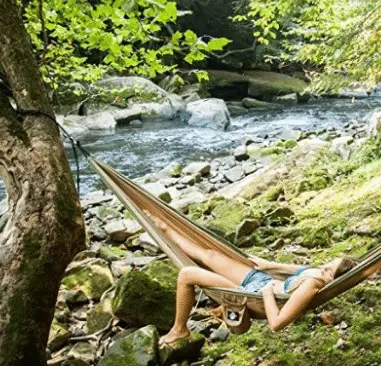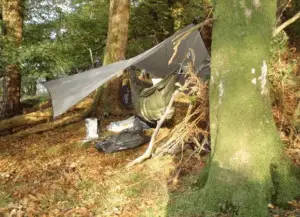
Hammocking isn’t necessarily a new practice as there’s a long history of hammocks being a legitimate choice when it comes to outdoor sleeping, however the modern resurgence of hammock use for camping as opposed to tents is a relatively new phenomenon.
While this can seem really strange to the traditional tent camper at first, there are plenty of pros going with a modern parachute hammock and enjoying everything it has to offer the avid outdoor enthusiast.
While this isn’t an option for people who camp in the desert or on the beach: areas that don’t have trees just make the hammock set up impossible. However in the forests, in the woods, even areas with just a couple trees all provide places where you can set up a great parachute hammock for camping and enjoy a beautiful night’s sleep underneath the stars – complete with mosquito/bug netting, if necessary, and a lot more comfortable with a good pad and your back off the (often) cold hard ground.
Whether you’re a long time tent camper, a hammock fan, or someone just starting out with your love of the great outdoors, hammocks are great to give a look, particularly for individuals or couples, so situations where a large family tent isn’t necessary.
Table of Contents
Hammocking
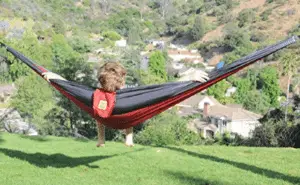 Hammocking is the commonly used term that refers to camping with a hammock as opposed to going the traditional tent route. There is a strongly growing community of campers and hikers who appear to be joining this surge, and there’s a lot to like about what these versatile camping gear bring to the table.
Hammocking is the commonly used term that refers to camping with a hammock as opposed to going the traditional tent route. There is a strongly growing community of campers and hikers who appear to be joining this surge, and there’s a lot to like about what these versatile camping gear bring to the table.
When set up properly, these camping hammocks are extremely low impact, comfortable, and opens up the natural world around you to truly enjoy what the outdoors have to offer. They are extremely versatile, holding up surprisingly well in circumstances that one would usually expect only really good tents to be able to hold up through.
Tents Versus Hammocks
This is where the big debate comes in, and there isn’t necessarily a correct answer either way, just preferences. Some people like the traditional idea of setting up a tent, and sleeping on the ground (albeit often with some padding). Even if the tent is made of a thin wall of nylon that realistically isn’t huge protection, there is something psychologically reassuring for many people to have that wall up.
Kind of the same way you blast the fans and AC during the summer but still sleep with a blanket on. There’s just something that feels over exposed if you don’t have that blanket. While there is no right or wrong answer, there’s a reason that hammocks are continuing to grow in popularity, and this is a pro/con topic that can definitely take up an entire blog post in and of itself.
Which is why if you want to know more you can click on our Tent camping vs hammock camping article to learn more.
Hammock Accessories You Need
There are many small hammocking accessories that you will want to get along with your camping hammock to make sure you can enjoy the great outdoors without running into any issues. The good news is that many of the best hammocks on the market also come with their own suspension system included but if yours doesn’t, or if it needs a replacement, then you will have plenty of options available.
Camping hammock straps
While you can technically use ropes, that’s not a great idea and you’re going to get some possibly less than friendly stares especially from eco-minded individuals. Hammock straps are by far and away a much better way to go. These do little to no damage to trees (unlike rope), are strong and firm enough to hold your weight securely, and hold up to the test of time.
There are many great choices when it comes to hammock straps that work perfectly with any hammock you order. Many even automatically come with their own straps and carabiners now, although replacement options are always readily available. In addition to being stronger than most rope, and unlikely to suddenly fray or break the way rope can, it won’t bite into the trees, damaging them.
As we stated before, and can’t state enough, we’re really big on using hammock straps if you’re hammocking. It really is the right practice.
Hammock carabiners
One of the really important pieces of equipment it is crucial to understand are carabiners. There are hammock specific carabiners and then hammocking carabiners – and it’s very important that rock climbers NEVER mix the two up. On the other hand, the ones popular with rock climbers can work for campers, but hammockers often are also ultralight backpackers and that means wanting to shave off every ounce while keeping equipment that works.
In fact, this topic is so important that we even have an entire blog post about hammock carabiners. You can look there for more information on what our favorite ones are, the difference between ultralight and heavy duty models, and everything else you could possibly want to know about new or replacement ones before your next outdoor adventure or even backyard setup.
Hammock rain fly
Well it can’t be a clear starry night every night, and when the weather does decide to finally turn on you, you want to be all set up and prepared for it. The good news is that whether it is ENO, Chill Gorilla, Hennessy, or another of the big names in the outdoor world that provide top notch gear, there is an overabundance of great choices to get an outstanding hammock rain fly to make sure you stay dry even when the heavens open up and the rain comes pouring down.
This is a good thing because as beautiful as a crystal clear sky full of stars can be while camping out at night, big purple rain clouds rolling in aren’t nearly as welcome a night time sight as the inside of a well pitched rain tarp for your hammock.
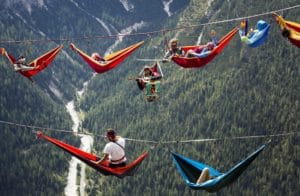
Extreme Hammocking
Extreme hammocking is definitely not for the faint of heart. As the name seems to indicate, this form of hammock camping goes way off the beaten path and is for the outdoor hammock campers who don’t just want to lay out underneath the open skies, but love to find those zip lines hanging 500 feet over a valley, scale up the side of a cliff face, or hang off the frame (underside) of an old metal bridge way up over the landscape.
This is definitely not for the faint of heart, but it goes to show the versatility of the hammock. Some people relax on a lazy Saturday afternoon, some people cut down on their ultralight backpack weight by switching out the small tent for a hammock, and then for others not using the hammock to hang hundreds of feet over a valley is just a waste.
To each their own, but for those who like to go on the extreme side, this might just be the outdoor past time that they’ve been looking for.
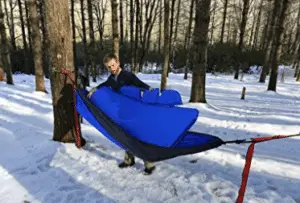 Winter Hammocking
Winter Hammocking
This definitely isn’t for everyone, and there are certain extreme temperatures where you just can’t recommend this (hello -44 in Alaska?), but there are many hammock campers who don’t see why a little bit of winter weather and a light dusting of snow on the ground should keep you from enjoying the great outdoors.
Obviously, the setup is critical when dealing with a winter camping hammock campsite. The rain fly is still important because it creates a little bit of a buffer to prevent heat from escaping (in addition to keeping snow from coming down and soaking into your sleeping bag). That being said, there are two pieces of equipment that you absolutely need: a truly good winter sleeping bag and you need a good hammock pad to give yourself a little bit of insulation that separates you from the bottom or edges of your hammock from the freezing air that is going to be outside.
Hammock pads
Winter hammocking is definitely not for everyone, and just as winter camping with tents or improvised shelters is an entirely different ballgame compared to the regular thing, it is very important to make sure to take all the necessary precautions to do it right. In the case of winter camping that means a rain fly (every little bit of heat you can keep in your sleeping area matters) a seriously good hat & scarf, an Arctic sleeping bag, and of course, hammock pads.
Hammock pads are a crucial part of winter hammock camping. They work as insulation by not only helping to keep your body heat in a “cocoon” but they put another layer of material between you and the freezing winter air. These pads are also used by many hammock campers to help firm up a wider base to sleep in so they feel a little less closed in and have a better set up for their preferred method of sleeping.
There are many options here and while an ultralight backpacker through summer probably isn’t looking for a pad, there are many regular hammock campers who see this as an absolutely essential part of any really good hammock setup.
| Hammock Pad | Avg Online Rating | Avg Cost | Overall Value |
|---|---|---|---|
 Fox Outfitters Ultralight Series Self Inflating Foam Camp Pad | 4.4 | $$ | A- |
 Klymit Static V2 Sleeping Pad | 4.4 | $$$+ | A- |
 Hennessy Hammock - Radiant Double Bubble Pad | 4.5 | $+ | A+ |
 Fox Outfitters Comfort Series Self Inflating Camp Pad | 4.5 | $$ | A |
 Hiker Hunger Ultra Lightweight Self Inflating Sleeping Pad | 4.8 | $$$ | B+ |
 Eagles Nest Outfitters - AirLoft Hammock Mattress | 5.0 | $$$$ | B+ |
Great video on setting up a winter hammock
Camping Hammock Pros
There are definitely many major positives to camping with a hammock as opposed to going the traditional tent route. For one thing, you don’t have to spend a lot of time looking for that perfect clear spot of ground before setting up, and then hoping that the ground is flat instead of angled, that there are no hidden sharp rocks, and that it is soft enough to give a decent night’s sleep.
Hammock Camping Pros:
- You don’t need flat cleared ground to camp out
- You don’t need to find an official campsite or cleared out campsite
- Many campers report a better night’s sleep
- More comfortable than tent camping in many ways
- You can pick out some pretty amazing views
- Lighter than tents – great for ultralight backpacking in wooded areas
- The price tends to be better
Camping Hammock Cons
As many benefits as there are to hammocking over tent camping, there are some definite drawbacks or cons to going this way, as well. There’s a reason we could write an entire long post on tents vs. hammocks, and as many YouTube videos as there are extolling the benefits of switching to a hammock, there are some who went the other direction. So what are some of the potential cons of hammocking?
Hammock Camping Cons:
- Can be a bit of a steep learning curve learning the right way to use them
- Not as sheltered from the elements as you would be with tents
- You can’t camp where there are no trees
- You are more exposed to the elements even with pads, sleeping bag, and rain tarp
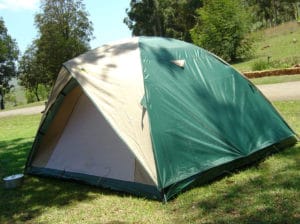
What About Tents?
There’s nothing wrong with tent camping, but there are many individuals, especially those who go solo or need to back ultra lightweight, who don’t like sleeping on the ground and find a lot more benefit from hammocks.
Just a few of the basic benefits that are reported from a widespread number of people includes much better sleep, less soreness, better back (less pain/stiffness), and more. However, in some situations tents are still going to be preferential.
There is one obvious place where tents are clearly the better option, and that’s any camp area that is devoid of trees. If you don’t have any trees in the area to set up a hammock, or no trees strong enough to support a hammock, then it’s not going to do much good. At that point it’s less good than just a plain sleeping bag to lay out cowboy style.
Some tent campers switch over to hammocks and never look back, while others prefer to stay with their more traditional methods. There is no right answer, but if you do a lot of ultralight long distance backpacking or frequent camping in heavily forested areas then you would be doing yourself a disservice if you didn’t at least give hammocking something of a trial run.
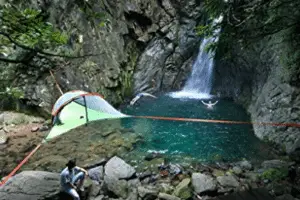 What Are Tent-Hammock Hybrids?
What Are Tent-Hammock Hybrids?
We just recently finished an article about these, which are a combination of a tent and a hammock. Most of them take the form of a small tent that is held off the ground, involving a triangular floor design that takes three hammock straps each going to the nearest tree to secure the hammock tent off the ground while still providing the fully enclosed benefits of a small tent.
Most of these are built for one or two people, although there are a few models that even allow you to fit three in based on a wider base and the careful layout of three people triangle shape – it admittedly doesn’t work if there’s one person who is particularly big or tall. These tend to be fairly popular with the hammock crowd who wants a little bit more or likes some of the benefits of hammocks but want to camp together as a group and/or have a limited number of options when it comes to strong enough trees in the area to setup.
These can sometimes be a good middle ground alternative between the two, although there are a fewer selections at this point compared to either tents or hammocks.
Hammock Camping FAQ
Q: What is hammocking?
Hammocking is simply a common term that is given to hammock camping. This is a general term that can involve anything from sleeping in a hammock over a tent to going the hammock direction during a long thru hike. Each situation is going to be a little bit different, but understand that this and hammock camping are basically the same term/terms.
Q: How do you keep warm while camping with a hammock?
There are a couple important practices here that can help a camper stay warm even in chilly fall weather. One step is to make sure you have a heavy duty sleeping bag to snuggle up in. There are many great bags rated from 30 degrees above zero to even 30 degrees below zero (though you don’t really want to be in a hammock at that point). The other important practice is to have a hammock pad between your body and the hammock’s bottom, that way cold won’t sap your body directly. This extra layer makes all the difference!
Q: What are hammock pads and what are they used for?
Hammock pads go in the hammock and can be used to help you get a little more supportive padding, set up a side sleeping situation, or work as a bit of insulation that puts padding/insulation between your body and the bottom cloth of the hammock which is exposed to cold air. This is especially important for winter hammocking.
Q: What is an ENO hammock?
ENO stands for Eagle Nest Outfitters. They are one of the biggest names in the camping hammock industry, and are often seen as the standard by which other companies are judged against. ENO isn’t the only top notch brand, but this abbreviation is so commonly used it is very possible to hear ENO and not know for a long time that it is an abbreviation for the full company name.
Q: How do you keep dry/warm during bad weather?
Keeping warm starts with keeping dry so these do go hand in hand. Hammock rain flys come in many different shapes and designs, giving you a wide array of options when it comes to setting up a tarp system so if the rain clouds come in, you won’t have to worry about it. These tarps should not only cover your entire hammock, but should also give a little bit of extra coverage on both sides, giving you a nice area effect.
Keeping warm is done in two ways. One of the big ones is to have a hammock pad. This not only gives a layer of padding that many people find comfortable and stabilizing but this also gives a degree of insulation from cold air so you don’t get CBA (cold butt affliction). The rest comes from choosing the appropriate sleeping bag for the season and a decent stocking cap.
Q: How do you clean a hammock?
Cleaning the hammock starts with removing the carabiners. Washing needs to be done with a gentle detergent, no fabric softener, no additives. Drying should NEVER be done with a dryer. Hang the hammock out on a clothesline during a sunny day, preferably warm and breezy is good as well. The carabiners can be washed by hand separately, using water and a scrub brush to make sure they’re clean.
In Conclusion
There’s no necessary right or wrong answers when it comes to hammock camping. For some people this is a fantastic alternative to tent camping, and vastly preferred for a variety of reasons. Other people find this a nice addition to a campsite, but not necessarily something they want replacing a tent.
Whatever your thoughts, it’s worth knowing that hammock camping provides an interesting new movement into the camping world and one that is going to continue to gain steam because of the extremely high quality of the many different types of camping hammocks currently being manufactured.
Basic Hammocking YouTube Video:
Other Great Resources:
Ultimate beginners hammock camping guide

